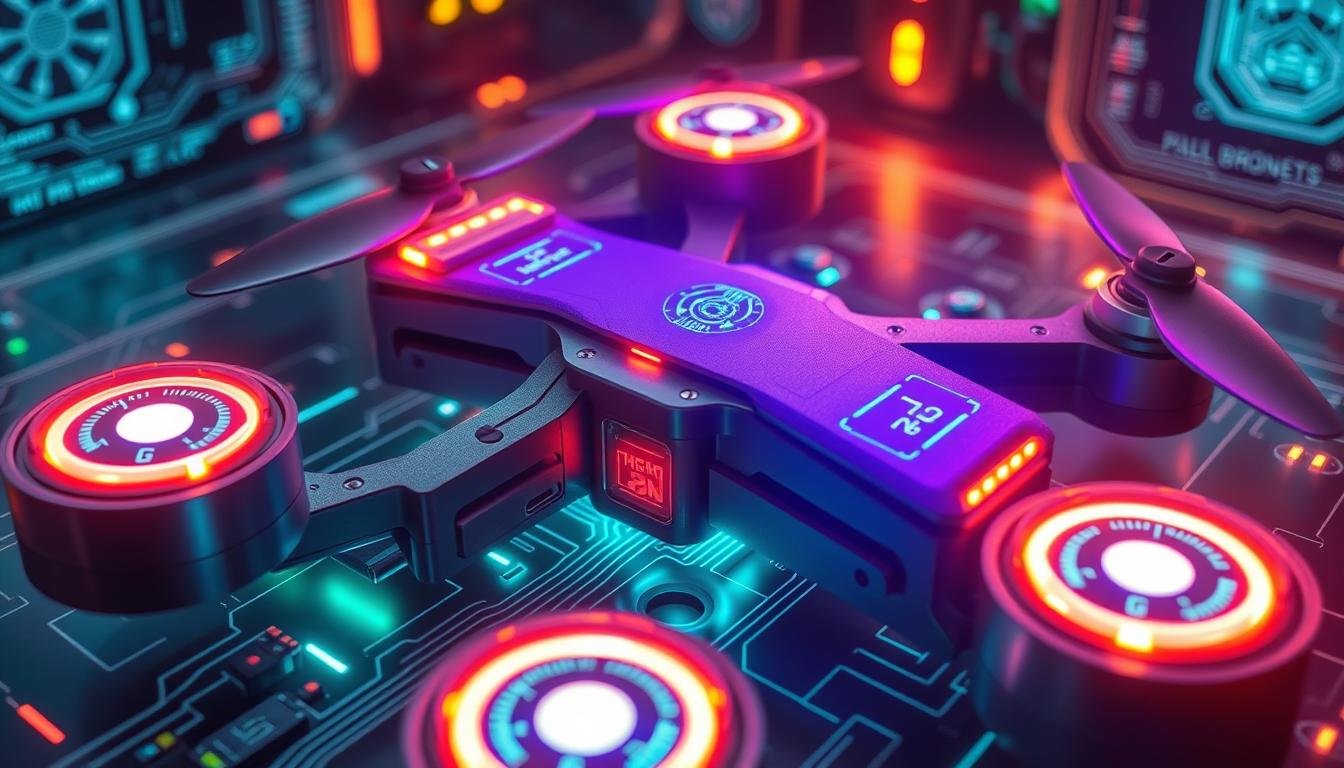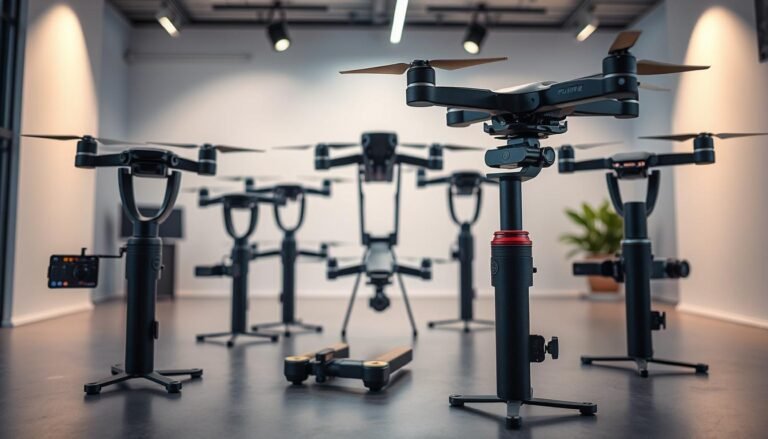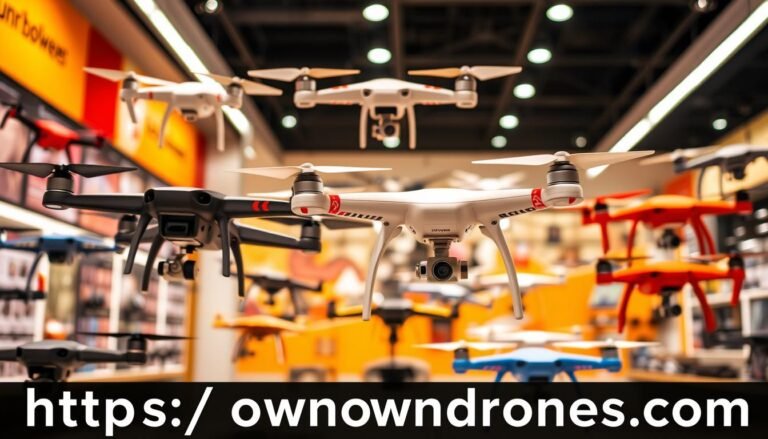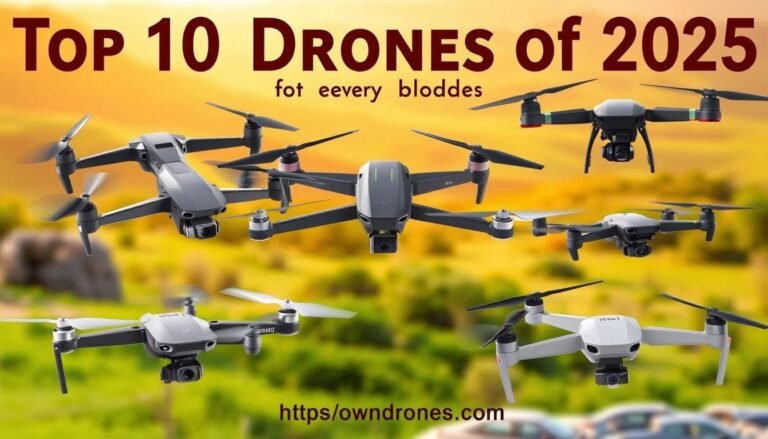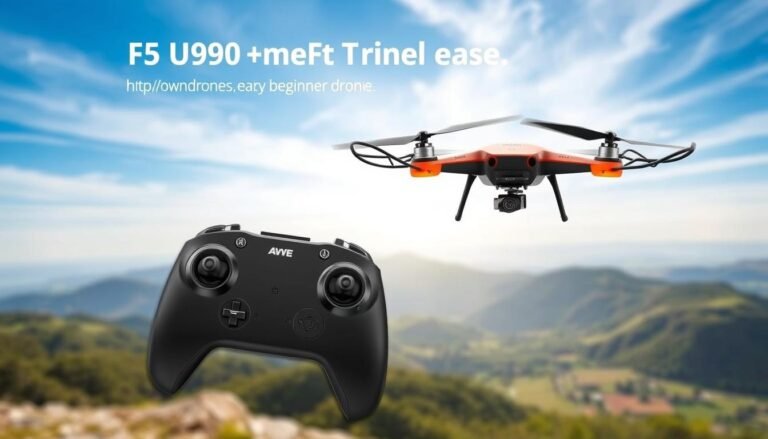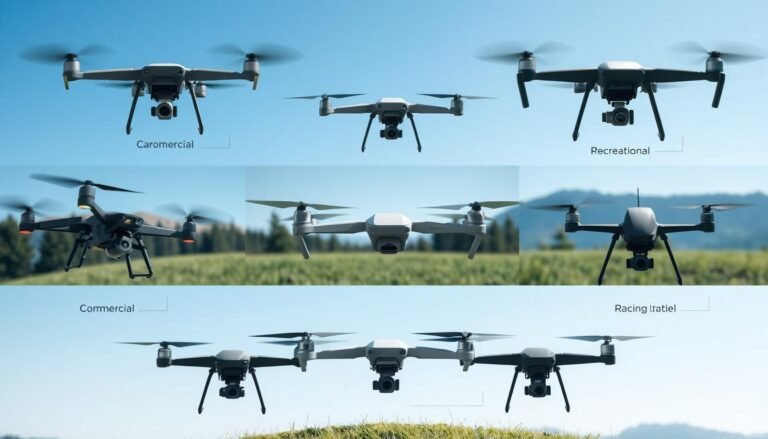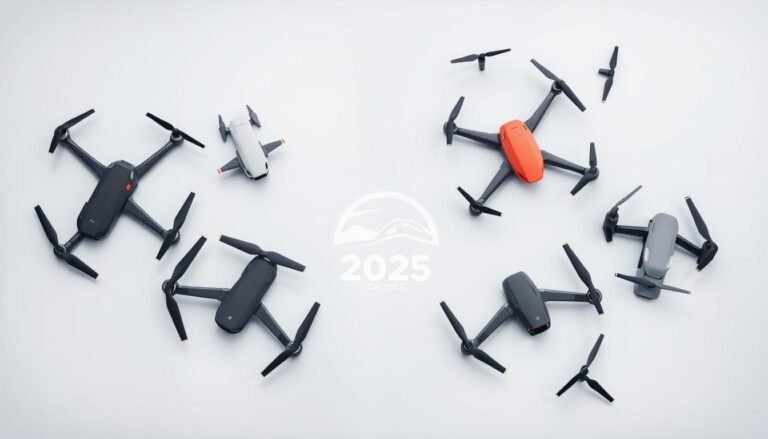Drone Batteries: Ultimate Guide to Power Your UAV in 2025
Tired of short flight times and constant battery swaps? Drone battery tech is set to change the game by 2025. New power solutions promise longer flights and better efficiency for UAVs.
We’ll explore the latest in drone batteries, from lithium polymer to hybrid systems. This guide covers trends, tech, and tips for all drone enthusiasts.
The drone accessories market is booming. Experts predict a 15.4% growth rate from 2023 to 2028. This surge comes from increased drone use across industries.
Drones are vital in agriculture, inspections, emergencies, and deliveries. As demand rises, so does the need for top-notch battery solutions.
Key Takeaways
- Discover the latest advancements in drone battery technology, including lithium polymer batteries, hybrid power solutions, and battery management systems.
- Learn how to choose the right battery type for your specific drone application, whether it’s long-range flights, heavy-lift operations, or agricultural missions.
- Understand the factors that affect drone battery performance, such as capacity, voltage, C-rating, and discharge rate.
- Gain insights into proper battery maintenance and care techniques, including charging, storage, and transportation best practices.
- Explore the future of drone batteries, including solid-state batteries and hydrogen fuel cells, and how they may shape the industry in the coming years.
Introduction to Drone Batteries
Drone batteries are the powerhouses of unmanned aerial vehicles (UAVs). They provide energy for flight, navigation, and payload operation. Understanding drone power is crucial for maximizing aircraft performance and battery life.
Various battery types power drones. Lithium Polymer (LiPo) batteries offer high power and long flight times. They need careful handling to prevent fire hazards. Lithium-Ion (Li-ion) batteries are heavier but more stable and safe.
Nickel Metal Hydride (NiMH) and Nickel Cadmium (NiCd) batteries are less common. NiMH batteries are durable, while NiCd batteries resist memory effect.
Choosing the right battery requires understanding key terms. Voltage (V) determines power output. Capacity (mAh) shows stored energy. C-rating reflects discharge rate. Cell count (S) affects overall voltage.
Energy density and cycle life impact battery performance and longevity. These factors are crucial when selecting a drone battery.
“A well-maintained LiPo battery can last between 300-500 charge cycles, with proper care extending its lifespan significantly.”
Proper drone battery maintenance ensures UAV longevity and safety. Regular inspections, safe charging, and cool storage are essential. Balanced chargers and smooth flying maximize battery life.
Troubleshooting steps include checking connections and inspecting the charger. Consider temperature effects when addressing battery issues.
New battery solutions are emerging to meet industry demands. Solid-state batteries offer improved energy density. Hydrogen fuel cells enable long-endurance flights. The future of drone power is exciting.
Stay informed about developments and follow best practices. This approach ensures your UAVs remain powered up and ready for flight.
Types of Drone Batteries
The battery you choose affects your drone’s flight time and performance. Lithium Polymer (LiPo) and Lithium-Ion (Li-Ion) are common drone batteries. They offer high energy density and lightweight designs for aerial use.
Lithium Polymer (LiPo) Batteries
LiPo batteries are popular for their high discharge rates and light weight. They’re great for racing drones and high-performance activities. LiPo batteries come in various types, including High Voltage LiPo (LiHV).
LiHV batteries provide higher voltage (4.35V) for increased capacity and power. This makes them ideal for drones needing quick energy bursts.
Lithium-Ion (Li-Ion) Batteries
Li-Ion batteries are common in smaller drones and those needing longer flight times. They’re heavier than LiPo batteries but offer a longer lifespan. Many consumer drones use Li-Ion batteries for impressive flight times.
For example, the DJI Phantom 4 Pro and Mavic 2 Pro can fly up to 30 minutes. This is thanks to their Li-Ion batteries’ high energy density.
Hybrid Power Solutions
Hybrid power solutions are emerging as alternatives to traditional battery systems. These combine different power sources to extend flight times and increase payload capacity. Some examples of hybrid drone power include:
- Fuel cells: Fuel cells convert hydrogen into electricity, offering longer flight durations and reduced environmental impact compared to batteries.
- Gasoline-electric hybrids: By combining a gasoline engine with an electric motor, these hybrid systems can significantly extend flight times while maintaining the benefits of electric propulsion.
Companies like UAVHE, Innoflight, and Skyfront are developing cutting-edge hybrid power systems. Yamaha Motor and H3 Dynamics are also pushing drone endurance and performance boundaries.
| Battery Type | Characteristics | Ideal Use Cases |
|---|---|---|
| LiPo | Lightweight, high discharge rates | Racing drones, high-performance activities |
| Li-Ion | High energy density, longer lifespan | Consumer drones, extended flight times |
| Hybrid Power | Combines benefits of different power sources | Long-endurance missions, increased payload capacity |
Factors Affecting Drone Battery Performance
Several factors determine drone battery performance and efficiency. Knowing these factors helps optimize flight time and overall performance. Let’s explore the key aspects influencing drone battery performance.
Capacity and Voltage
Battery capacity, measured in milliamp-hours (mAh), affects a drone’s flight time. Higher capacity batteries store more energy, allowing longer flights.
Voltage impacts the battery’s power output. Higher voltage batteries give more power to motors. This enables faster speeds and better performance in windy conditions.
C-Rating and Discharge Rate
A battery’s C-rating shows its maximum safe discharge rate. Higher C-ratings let batteries deliver more current to motors. This results in better performance and responsiveness.
Discharge rate, measured in amps, determines how fast a battery releases energy. High-performance drone motors need batteries with high C-ratings and discharge rates.
Weight and Size
Battery weight and size affect the drone’s overall weight and flight characteristics. Lighter batteries allow longer flight times and better maneuverability.
Larger batteries may offer more capacity but increase weight. Finding the right balance between battery weight and size is crucial.
“Balancing battery capacity, voltage, C-rating, discharge rate, weight, and size is essential for maximizing drone performance and flight time.”
When choosing a drone battery, consider these factors:
- Higher capacity batteries (measured in mAh) generally result in longer flight times
- Higher voltage batteries provide more power to the motors, enabling faster speeds and better wind resistance
- High C-ratings allow for faster discharge rates, improving drone responsiveness and performance
- Lightweight batteries can extend flight times and enhance maneuverability
- Compact battery size is essential for maintaining optimal drone weight and balance
Understanding these factors helps you choose the right battery for your needs. This ensures your drone operates at its best. You’ll enjoy longer flight times and improved performance.
Choosing the Right Drone Battery
Picking the perfect drone battery is key to maximizing your UAV’s performance. Consider your drone’s flight time needs, payload capacity, and battery compatibility. These factors help balance battery weight, size, and overall performance.
Lithium Polymer (LiPo) batteries are top picks for drones. They offer high energy density and excellent discharge rates. LiPo batteries come in various voltages, from 3.7V (1S) to 22.2V (6S) or higher.
The Gens ace 6S LiPo Battery 22.2V 2200mAh 45C is great for larger drones. It weighs 365g and measures 105 x 34 x 44 mm.
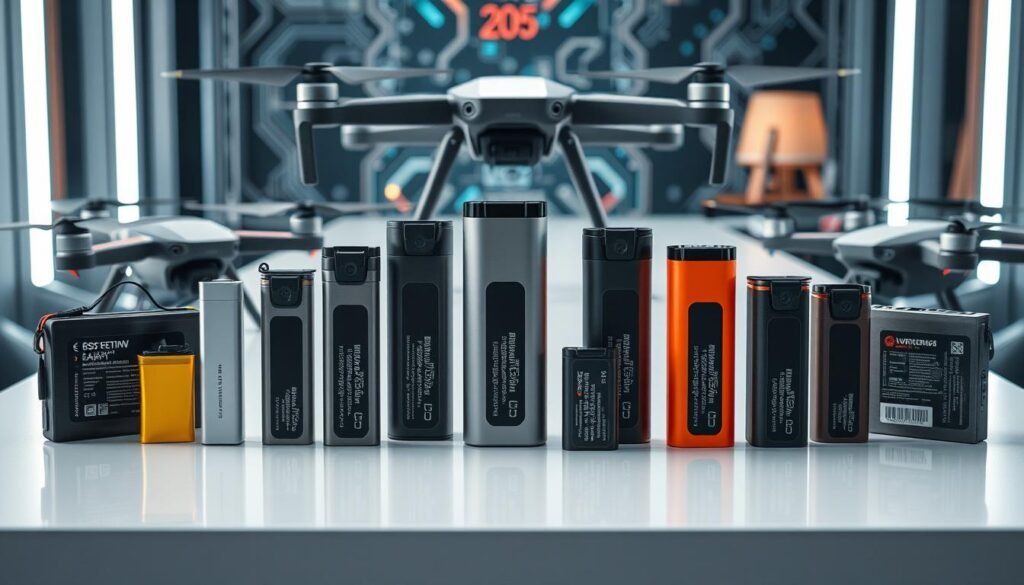
Battery capacity is crucial in drone battery selection. Higher-capacity batteries give longer flight times but may increase weight. Consumer drones typically fly for 10 to 30 minutes.
Larger industrial drones can last up to an hour or more. Smaller drones use 450mAh to 1300mAh batteries. Larger drones may need 1500mAh to 30000mAh or more.
The discharge rate, or C rating, matters for high-performance drones. A higher C rating allows for greater peak currents. This ensures the battery meets power demands during tough maneuvers.
The URGENEX 7.4V 5200mAh Lipo Battery has a 70C discharge rate. It’s great for drones needing high power output.
Always check battery compatibility with your specific UAV model. Make sure the battery’s size, connector type, and voltage match your drone. This prevents damage and ensures optimal performance.
Drone Battery Maintenance and Care
Proper care extends drone battery life and ensures safe operation. Follow best practices for drone battery charging, storage, and transportation. Use battery monitoring systems to optimize performance and reduce risks.
Proper Charging Techniques
Use the recommended charger and follow manufacturer guidelines. Well-maintained drone batteries can last 100 to 300 charge cycles. Charging times depend on battery capacity.
- Smaller batteries (around 1,000mAh) may take 30-60 minutes to charge fully with a standard charger.
- Larger batteries (5,000mAh or more) can take several hours to charge fully.
- Fast chargers can charge a battery in 15-30 minutes but may reduce the overall lifespan if used frequently.
Storage and Transportation
Store drone batteries at 22 to 28°C for optimal health. Protect batteries from damage and extreme temperatures during transport. For dual-battery drones, keep pairs together for balanced performance.
Battery Monitoring and Management Systems
Battery monitoring systems (BMS) help prevent overcharging and over-discharging. Many modern drones have built-in BMS accessible through the manufacturer’s app. These systems provide info on battery health, charge, and cycle count.
| Drone Model | Flight Time | Battery Capacity | BMS Features |
|---|---|---|---|
| DJI Mavic Air 2 | 34 minutes | 3,500mAh | Intelligent Battery Management System |
| Parrot Anafi | 25 minutes | 2,700mAh | Smart Battery with charge level LED indicators |
| Autel EVO II | 40 minutes | 7,100mAh | Intelligent Battery Management System |
Good battery care ensures top performance and extends lifespan. With proper maintenance, you’ll enjoy safe and reliable flights for years.
Innovations in Drone Battery Technology
The drone industry is evolving, and so are the batteries that power these machines. Solid-state batteries and hydrogen fuel cells are two groundbreaking innovations. These technologies promise extended flight time, improved safety, and enhanced performance for drones.
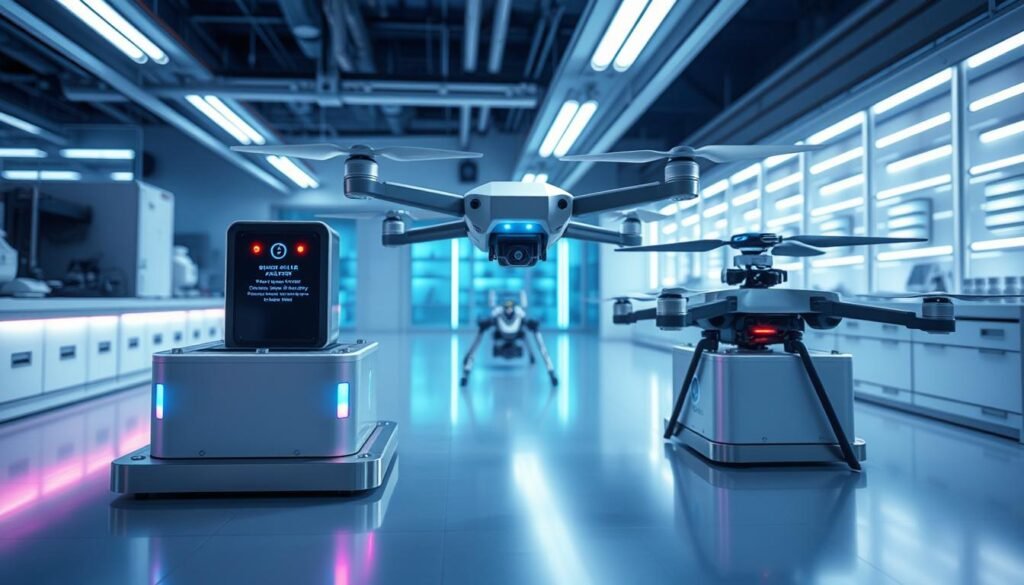
Solid-State Batteries
Solid-state batteries are a big step forward in drone battery technology. They use a solid electrolyte instead of a liquid one. This change offers higher energy density, faster charging times, and improved safety.
With solid-state batteries, drones can fly longer and recharge quickly. They also operate with less risk of overheating or short-circuiting.
| Battery Technology | Energy Density (Wh/kg) | Charge/Discharge Cycles |
|---|---|---|
| Lithium-Ion (Li-Ion) | 150-250 | 500-1,000 |
| Solid-State | 400+ | 1,000+ |
Hydrogen Fuel Cells
Hydrogen fuel cells are another exciting innovation for drone batteries. They generate electricity through a chemical reaction between hydrogen and oxygen. The only byproducts are water and heat.
These cells offer higher energy density, longer flight times, and less environmental impact. Companies like H3 Dynamics are developing lightweight hydrogen fuel cell systems for drones.
The development of advanced drone power solutions, such as solid-state batteries and hydrogen fuel cells, will unlock new possibilities for drone applications and push the boundaries of what these incredible machines can achieve.
These new battery technologies will lead to drones with longer flight times and better performance. They will also have less impact on the environment. These advances will shape the future of drones.
New applications will become possible as these technologies improve. The limits of unmanned aerial vehicles will be pushed even further.
Top Drone Battery Manufacturers
The battery is vital for your drone’s performance and safety. Selecting a reliable, high-performance battery from a trusted maker is crucial. Let’s explore some leading drone battery manufacturers.
DJI
DJI is renowned for its drone batteries. They’re designed for DJI drones, ensuring optimal performance and compatibility. These batteries have advanced safety features to protect your drone during operation.
Parrot
Parrot offers high-quality drone batteries known for reliability and long flight times. They’re ideal for aerial photography and videography enthusiasts. Parrot batteries include built-in safety mechanisms to prevent accidents and extend lifespan.
Yuneec
Yuneec produces its own line of battery packs. They provide stable power output and long flight times, even in tough weather. Yuneec batteries feature intelligent management systems that monitor health and prevent charging issues.
Autel Robotics
Autel Robotics’ power systems are gaining popularity among drone enthusiasts. They’re known for high energy density and fast charging capabilities. This allows more flying time and less waiting for batteries to charge.
| Manufacturer | Battery Type | Capacity (mAh) | Voltage (V) |
|---|---|---|---|
| DJI | LiPo | 5870 | 15.2 |
| Parrot | LiPo | 2700 | 11.1 |
| Yuneec | LiPo | 5400 | 14.8 |
| Autel Robotics | LiPo | 7100 | 22.2 |
When picking a drone battery, consider capacity, voltage, and compatibility with your drone model. Choosing from reputable brands ensures you get a high-quality, reliable power source for your drone.
Drone Batteries for Specific Applications
The drone industry’s growth has led to a surge in specialized battery solutions. Each use case, from long-range flights to heavy-lift operations, presents unique power challenges.
These challenges require innovative solutions tailored to specific applications. Agricultural tasks also demand specialized power sources to meet their unique needs.
Long-Range Flights
Long-range drone flights need high-capacity batteries with exceptional energy efficiency. These long-range drone batteries often use advanced cell chemistries like lithium-ion or lithium-polymer.
Such batteries offer high energy densities and low self-discharge rates. The Ufine 3.7V 1600mAh High Rate Discharge Battery is a good example.
It maintains over 80% capacity after 500 cycles. This makes it suitable for extended missions requiring long flight times.
Heavy-Lift Drones
Heavy-lift drones transport substantial payloads and need robust power systems. These systems must deliver high discharge rates and sustained performance.
Heavy-lift UAV power solutions often use high-capacity batteries with elevated C-ratings. This ensures ample current delivery to support increased weight and power demands.
The Yowoo 2 Packs 4S Lipo Battery 3000mAh 150C 14.8V is a prime example. It offers high discharge rates and substantial capacity.
Agricultural Drones
Agricultural drone batteries must endure prolonged operation in challenging environments. These specialized drone power solutions prioritize durability, reliability, and extended flight times.
Such features maximize efficiency in tasks like crop monitoring and fertilizer application. The DJI AGRAS T50 is a leading agricultural drone with a robust power system.
It effectively carries and dispenses heavy loads of agricultural products. This demonstrates the importance of specialized batteries in agricultural applications.
| Application | Battery Requirements | Example Battery |
|---|---|---|
| Long-Range Flights | High capacity, excellent energy efficiency | Ufine 3.7V 1600mAh High Rate Discharge Battery |
| Heavy-Lift Drones | High discharge rates, substantial capacity | Yowoo 2 Packs 4S Lipo Battery 3000mAh 150C 14.8V |
| Agricultural Drones | Durability, reliability, extended flight times | DJI AGRAS T50 (integrated power system) |
Battery makers are creating more specialized solutions as drone technology advances. They tailor battery specs to meet unique needs of various applications.
This customization helps drone operators boost performance and efficiency. It also contributes to overall mission success in different drone applications.
Conclusion: The Future of Drone Batteries
Drone battery technology is evolving rapidly. The global market is expected to reach $9.6 billion by 2028. Lithium batteries are improving in energy density, charging speed, and safety.
New chemistries like lithium-sulfur, lithium-air, and solid-state lithium are being developed. Researchers are also exploring hydrogen fuel cells and renewable energy sources. These options aim to be high-performance, cost-effective, and eco-friendly.
Current challenges include limited flight times and long charging periods. Safety concerns are also being addressed. The next generation of batteries will enable longer flights and safer operations.
Improved battery technology will transform drone design and performance. This will impact various sectors, from aerial photography to delivery services. Drones will have increased capabilities, opening up new possibilities.
Stay informed about the latest developments in drone batteries. Visit https://owndrones.com for up-to-date information on these groundbreaking advancements.
